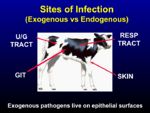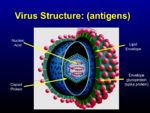Difference between revisions of "Host invasion by microorganisms"
| Line 10: | Line 10: | ||
=[[Viruses - WikiBlood|Viruses]]= | =[[Viruses - WikiBlood|Viruses]]= | ||
| + | [[Image:Virus structure.jpg|thumb|right|150px|Virus Structure - B. Catchpole, RVC 2008]] | ||
| + | ==Structure== | ||
| − | |||
==Replication== | ==Replication== | ||
==Routes of infection== | ==Routes of infection== | ||
Revision as of 11:03, 21 August 2008
Introduction
Infection is a primary cause of disease. Three pathways of infection are identified: bacterial, viral, and parasitic. In all three cases, microorganisms can display similar characteristics. They can manifest as primary (obligate) pathogens or secondary (opportunistic) pathogens, the former of which always corresponds to disease, and the latter of which depends on prerequisites being fulfilled before causing disease. As such, secondary pathogens can be found in healthy animals, but they lie in wait until a primary cause compromises the immune system and then manifest symptoms. Secondary pathogens can even masquerade as commensal organisms, or those which operate in harmony with the animal, until they become pathogenic.
Microorganisms can enter the body by three routes: contact (typically dermatological infection), aerosol (typically respiratory infection), or orofecal (typically enteric infection). Infection can be either exogenous (via entry to epithelial surfaces) or endogenous (intracellular, extracellular, or vesicular).

